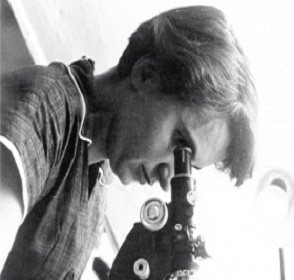
In the history of science there are pivotal moments, Newton’s apple, Edison’s light bulb, Fleming discovering penicillin, but to me one of the most notable moments of recent time has to be the discovery of the structure of DNA. The code of life itself, the double helix is arguably responsible for making us the people we are.
The discovery of the structure has led to the birth of modern genetics and genomics including: the mapping of the genome, genetic fingerprinting, gene therapy and genetic modification of foods. In fact the ability to sequence and manipulate DNA is now central to biotechnology and modern medicine.
Watson and Crick are the scientists synonymous with DNA structure, but it was the X-ray diffraction images of DNA which led to the discovery of the DNA double helix. These images produced by the work of the lesser known Rosalind Franklin.
Rosalind Elsie Franklin (25 July 1920-16 April 1958) English chemist and X-ray crystallographer is best known for her work on the X-ray diffraction images confirming the helical structure of DNA. These images were shown to Watson without her approval or knowledge by fellow scientist Maurice Wilkins. This provided valuable insight into DNA structure, but Franklin's scientific contributions to the discovery of the double helix are often overlooked.
Watson and Crick had been working on a DNA model with the chains inside and the bases pointing outwards, until being shown Franklin’s photograph. Upon seeing the photograph, Watson is reported to have said, "My jaw fell open and my pulse began to race," Using the information shown within this image Watson and Crick went on to develop their famous model of DNA, published on 25 April 1953.
When publishing their model in Nature magazine, they included a footnote acknowledging that they were "stimulated by a general knowledge" of Franklin's and Wilkins' unpublished contribution. Wilkins' and Franklin's articles were published second and third in the same edition of Nature so it looked as though they were supporting Crick and Watson's model. Raymond Gosling, who worked with Franklin on the famous images, reports Franklin's response to seeing the model that Watson and Crick had built, as “We all stand on each other’s shoulders.”
Franklin left King's College in March 1953 and relocated to Birkbeck College, where she studied the structure of the tobacco mosaic virus and the structure of RNA. Franklin published 17 papers on viruses, and her group laid the foundations for structural virology. In 1962, Crick, Watson and Wilkins received the Nobel Prize. Franklin died, six years earlier. Would she have received the award?
Getting children excited about science is very much part of what school is about. In fact the primary curriculum asks us to do so. The story of Rosalind Franklin and the structure of DNA is one of emotion, injustice and lack of recognition, which resonates well in any time.
For curriculum linked resources on evolution, inheritance and DNA please visit:
- Year 6 Evolution and inheritance
- Inheritance, DNA and variation
- As part of the National STEM Centre’s celebration of the two millionth visitor to its website, we are running a poll to find the greatest STEM champion.
Vote for Rosalind Franklin because, as well as being one of the key scientists in this breakthrough discovery, Rosalind Franklin embodies many virtues that we try to instil in children as they develop - hardworking, attention to detail, concentration, humility, allowing others to shine whilst she was instrumental in them shining! Who better to be a role model for any child, male or female, to uphold as one of their STEM heroes/heroines!
This survey is now closed. Thank you for your contributions and you can view the final results.
